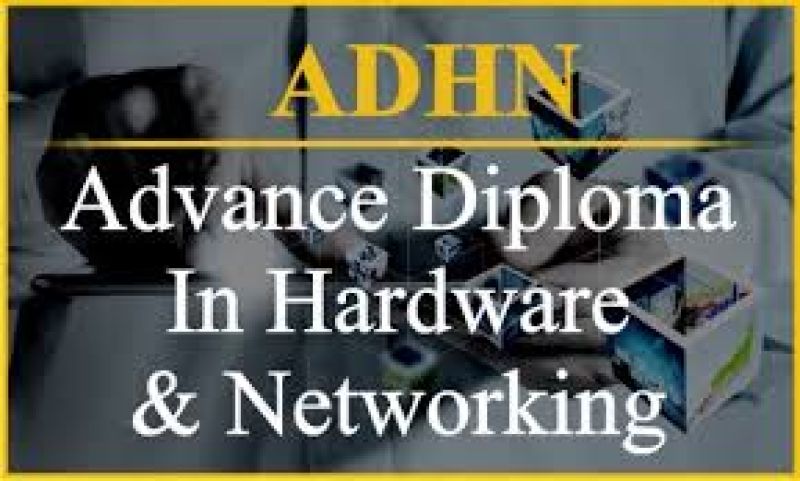The Advanced Diploma in Hardware and Networking is a comprehensive 12-month course designed to provide students with advanced knowledge and practical skills in the areas of computer hardware, network setup, management, and troubleshooting. This course is ideal for individuals aspiring to become network engineers, hardware technicians, or IT support specialists, as it covers both the technical aspects of hardware maintenance and the principles of networking.
Syllabus for Advanced Diploma in Hardware and Networking (12 Months)
Semester 1: Introduction to Computer Hardware and Networking Fundamentals
-
Introduction to Computer Hardware
- Basics of computer systems and components
- Types of hardware: Input devices, output devices, storage devices, and peripherals
- Computer architecture and motherboard components
- Power supplies, cooling systems, and troubleshooting hardware issues
- Assembly and disassembly of computers
- Upgrading and repairing hardware components (RAM, hard drives, CPU, etc.)
-
Operating Systems and Their Functions
- Introduction to operating systems (Windows, Linux, macOS)
- Installation and configuration of operating systems
- File systems: NTFS, FAT32, and ext3
- User management and permissions
- System utilities and task management tools
-
Basic Networking Concepts
- Introduction to computer networks: Types and topologies (LAN, WAN, MAN)
- Basic networking components: Routers, switches, hubs, and cables
- OSI and TCP/IP models and layers
- IP addressing and subnetting
- Introduction to wireless networking (Wi-Fi) and mobile networks
-
Networking Devices and Configuration
- Working with routers and switches
- Configuration of network devices and cable types
- Ethernet, coaxial, fiber optic cables, and wireless communication
- IP address management and DNS
- Introduction to DHCP (Dynamic Host Configuration Protocol)
-
Basic Troubleshooting of Computer Hardware and Networks
- Identifying and diagnosing hardware problems
- Common hardware failure symptoms and solutions
- Troubleshooting network connectivity issues
- Using diagnostic tools (ping, tracert, nslookup, etc.)
Semester 2: Advanced Hardware and Network Configuration
-
Advanced Computer Hardware
- Understanding the role of the CPU, motherboard, RAM, and BIOS/UEFI settings
- Expansion cards: Graphic cards, sound cards, and network interface cards (NIC)
- Advanced storage devices: SSD, RAID configurations, NAS, SAN
- Printers and scanners: Installation, configuration, and troubleshooting
- Mobile device hardware (smartphones, tablets)
-
Advanced Networking Concepts
- Network addressing: Subnetting, CIDR, and IP classes
- Routing and switching: Static routing, dynamic routing, and VLANs (Virtual Local Area Networks)
- Advanced wireless networking concepts (Wi-Fi standards, security protocols, and network design)
- Network security fundamentals: Firewalls, encryption, VPNs, and intrusion detection systems (IDS)
- Quality of Service (QoS) in networking
-
Server Configuration and Management
- Server types: File servers, web servers, mail servers, and database servers
- Installation and configuration of servers (Windows Server, Linux Server)
- Server roles: DHCP, DNS, Active Directory, and file sharing
- Configuring and managing network shares and user permissions
- Setting up remote access and VPN
-
Network Security and Cybersecurity Basics
- Introduction to network security concepts and tools
- Network security protocols: SSL/TLS, VPNs, and IPsec
- Firewall configuration and management
- Antivirus and anti-malware software
- Cybersecurity best practices: Data protection, backup, and disaster recovery
-
Advanced Troubleshooting and Maintenance
- Advanced hardware troubleshooting: Fault isolation, diagnostic tools, and repair techniques
- Network troubleshooting: Analyzing and resolving performance issues
- Monitoring tools: SNMP, Wireshark, NetFlow, and others
- Preventive maintenance of hardware and network infrastructure
Semester 3: Practical Implementation and Industry Skills
-
Practical Networking Setup
- Setting up and configuring a local area network (LAN)
- Connecting different devices (computers, printers, and servers) in a network
- Implementing routing and switching in a small network
- Configuring wireless networks and ensuring secure Wi-Fi access
- Troubleshooting network connectivity and performance issues
-
Advanced Hardware and Network Integration
- Integrating hardware and network devices in a corporate environment
- Configuring network-attached storage (NAS) and managing shared resources
- Hands-on work with cloud services and hybrid networking models
- Building a network infrastructure for a small to medium-sized business
-
Virtualization and Cloud Computing
- Introduction to virtualization technologies: VMware, Hyper-V, and VirtualBox
- Setting up virtual machines and virtual networks
- Cloud computing concepts: Public, private, and hybrid clouds
- Cloud service models (IaaS, PaaS, SaaS)
- Configuring virtualized environments and managing cloud resources
-
Project Work and Case Studies
- Industry-relevant projects, such as setting up a complete network for an office or troubleshooting network and hardware problems
- Real-world case studies on network setup, hardware maintenance, and network security implementation
- Students will work on a project that demonstrates their ability to apply all the skills learned throughout the course
-
Soft Skills and Professional Development
- Communication skills for IT professionals
- Documentation, report writing, and presentation techniques
- Problem-solving and critical thinking for troubleshooting
- Professional ethics in IT and customer support
- Preparing for certification exams (e.g., CompTIA A+, Cisco CCNA, Microsoft Certified Professional)
Additional Features:
- Internship: Many institutions offer an internship as part of the course where students can gain hands-on experience in real-world IT environments.
- Workshops and Seminars: Special sessions may be conducted by industry professionals on emerging technologies in hardware and networking.
Career Opportunities:
Graduates of the Advanced Diploma in Hardware and Networking can pursue roles such as:
- Network Engineer
- Hardware Technician
- IT Support Specialist
- Network Administrator
- Systems Administrator
- Network Security Analyst
- IT Consultant
- Technical Support Engineer
Duration:
The Advanced Diploma in Hardware and Networking is typically completed in 12 months (one year), with both theoretical learning and practical hands-on experience.
This program equips students with the necessary knowledge to build, maintain, and secure network infrastructure, making it an excellent choice for individuals looking to enter the rapidly expanding IT field.
